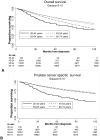Treatment and survival outcomes in young men diagnosed with prostate cancer: a Population-based Cohort Study
- PMID: 19466697
- PMCID: PMC2948666
- DOI: 10.1002/cncr.24324
Treatment and survival outcomes in young men diagnosed with prostate cancer: a Population-based Cohort Study
Abstract
Background: Outcomes of treatment for young men compared with older men with prostate cancer are poorly defined outside of limited institutional series. In this study, the authors examined the association between age at diagnosis and grade, stage, treatment, and survival outcomes in men who were diagnosed during the era of prostate-specific antigen testing.
Methods: The National Cancer Institute's Surveillance, Epidemiology, and End Results database was used to identify men who were diagnosed with prostate cancer between 1988 and 2003. Men ages 35 years to 74 years were stratified by age at diagnosis to examine differences in tumor characteristics, treatment, and survival within each age group.
Results: In total, 318,774 men ages 35 years to 74 years were identified who had been diagnosed with adenocarcinoma of the prostate between 1988 and 2003. The proportion of men aged < or =55 years at diagnosis increased over the study period from 2.3% between the years 1988 and 1991 to 9% between the years 2000 and 2003, and the median age at diagnosis decreased from 72 years in 1988 to 68 years in 2003. Younger men were diagnosed less frequently with organ-confined tumors (P < .001) but were less likely to be diagnosed with high-grade cancer (P < .001). Older men were more likely to receive no local therapy or external beam radiation than young men (P < .001 for trend). Among men who had tumors with a Gleason score between 5 and 7, overall survival was worse with advancing age. However, among all age groups with high grade and stage, the youngest men (ages 35-44 years) were at the highest risk of all-cause and cancer-specific death.
Conclusions: Age at diagnosis among men with prostate cancer continued to decline. Younger men were more likely to undergo prostatectomy, have lower grade cancer, and, as a group, to have better overall and equivalent cancer-specific survival at 10 years compared with older men. Among men with high grade and locally advanced prostate cancer, the youngest men had a particularly poor prognosis compared with older men.
Figures



References
-
- Bleyer A. Young adult oncology: the patients and their survival challenges. CA Cancer J Clin. 2007;57(4):242–55. - PubMed
-
- Kotsis SV, Spencer SL, Peyser PA, Montie JE, Cooney KA. Early onset prostate cancer: predictors of clinical grade. J Urol. 2002;167(4):1659–63. - PubMed
-
- Khan MA, Han M, Partin AW, Epstein JI, Walsh PC. Long-term cancer control of radical prostatectomy in men younger than 50 years of age: update 2003. Urology. 2003;62(1):86–91. discussion 91-2. - PubMed
-
- Rosser CJ, Chichakli R, Levy LB, Kuban DA, Smith LG, Pisters LL. Biochemical disease-free survival in men younger than 60 years with prostate cancer treated with external beam radiation. J Urol. 2002;168(2):536–41. - PubMed
-
- Smith CV, Bauer JJ, Connelly RR, Seay T, Kane C, Foley J, et al. Prostate cancer in men age 50 years or younger: a review of the Department of Defense Center for Prostate Disease Research multicenter prostate cancer database. J Urol. 2000;164(6):1964–7. - PubMed
Publication types
MeSH terms
Substances
Grants and funding
LinkOut - more resources
Full Text Sources
Other Literature Sources
Medical

